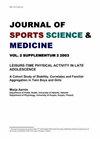急性负荷诱导疲劳、急性血清激素反应和训练量对10周力量训练中个体肥大和最大力量的影响。
IF 2.4
2区 医学
Q2 SPORT SCIENCES
引用次数: 1
摘要
本研究调查了力量训练引起的急性疲劳是否与个体在最大力量和/或肌肉肥大方面的力量训练适应有关,以及训练期间血清睾酮(T)和生长激素(GH)浓度的急性反应是否与个体神经肌肉适应有关。26名男性完成了为期10周的力量训练干预,其中包括在第2周、第4周、第6周和第10周的疲劳动态腿部按压急性负荷(5 x 10 RM)。在第2周、第6周和第10周,在负荷前后和恢复24小时后采集血样,测定血清T、GH和皮质醇(C)浓度。超声测量股外侧肌横截面积。在加载前和加载后立即进行等距力测量,加载引起的最大力急剧下降被报道为疲劳百分比。根据训练结束后肌肉肥大的程度将受试者分为三组。高反应者(HR, n = 10)和中等反应者(MR, n = 7)的等长力增加显著(增加24.3%±17.2,p = 0.035),而低反应者(LR, n = 7)的等长力增加不显著(增加26.2%(±16.5))。在所有组的每个测量点上,工作量(cm + s)都显著增加。整个组的疲劳率与训练结束后等距力的相对变化呈显著相关(R = 0.475, p = 0.022),仅与HR相关(R = 0.643, p = 0.049)。只有HR组在每个测量点显示急性血清GH浓度升高。在第6周和第10周,血清T - HR也有明显的急性升高。HR显示急性负荷引起的疲劳与等长力增益之间的相关性最强。负荷后,HR对血清T和GH浓度的急性升高也更为敏感。急性疲劳和血清生长激素浓度可能是肌肉力量增加的反应性指标,在某种程度上,肌肉肥大。本文章由计算机程序翻译,如有差异,请以英文原文为准。
Effects of Acute Loading Induced Fatigability, Acute Serum Hormone Responses and Training Volume to Individual Hypertrophy and Maximal Strength during 10 Weeks of Strength Training.
This study investigated whether a strength training session-induced acute fatigue is related to individuals' strength training adaptations in maximal force and/or muscle hypertrophy, and whether acute responses in serum testosterone (T) and growth hormone (GH) concentrations during the training sessions would be associated with individual neuromuscular adaptations. 26 males completed the 10-week strength-training intervention, which included fatiguing dynamic leg press acute loading bouts (5 x 10 RM) at weeks two, four, six, and ten. Blood samples were collected before and after the loading and after 24h of recovery for serum T, GH, and cortisol (C) concentrations at weeks 2, 6, and 10. The cross-sectional area of the vastus lateralis was measured by ultrasonography. Isometric force measurements were performed before and immediately after loadings, and loading-induced acute decrease in maximal force was reported as the fatigue percentage. The subjects were split into three groups according to the degree of training-induced muscle hypertrophy after the training period. Increases in isometric force were significant for High Responders (HR, n = 10) (by 24.3 % ± 17.2, p = 0.035) and Medium Responders (MR, n = 7) (by 23.8 % ± 5.5, p = 0.002), whereas the increase of 26.2 % (±16.5) in Low Responders (LR, n = 7) was not significant. The amount of work (cm + s) increased significantly at every measurement point in all the groups. A significant correlation was observed between the fatigue percentage and relative changes in isometric force after the training period for the whole group (R = 0.475, p = 0.022) and separately only in HR (R = 0.643, p = 0.049). Only the HR group showed increased acute serum GH concentrations at every measurement point. There was also a significant acute increase in serum T for HR at weeks 6 and 10. HR showed the strongest correlation between acute loading-induced fatigue and isometric force gains. HR was also more sensitive to acute increases in serum concentrations of T and GH after the loading. Acute fatigue and serum GH concentrations may be indicators of responsiveness to muscle strength gain and, to some extent, muscle hypertrophy.
求助全文
通过发布文献求助,成功后即可免费获取论文全文。
去求助
来源期刊
CiteScore
5.60
自引率
6.20%
发文量
56
审稿时长
4-8 weeks
期刊介绍:
The Journal of Sports Science and Medicine (JSSM) is a non-profit making scientific electronic journal, publishing research and review articles, together with case studies, in the fields of sports medicine and the exercise sciences. JSSM is published quarterly in March, June, September and December. JSSM also publishes editorials, a "letter to the editor" section, abstracts from international and national congresses, panel meetings, conferences and symposia, and can function as an open discussion forum on significant issues of current interest.

 求助内容:
求助内容: 应助结果提醒方式:
应助结果提醒方式:


